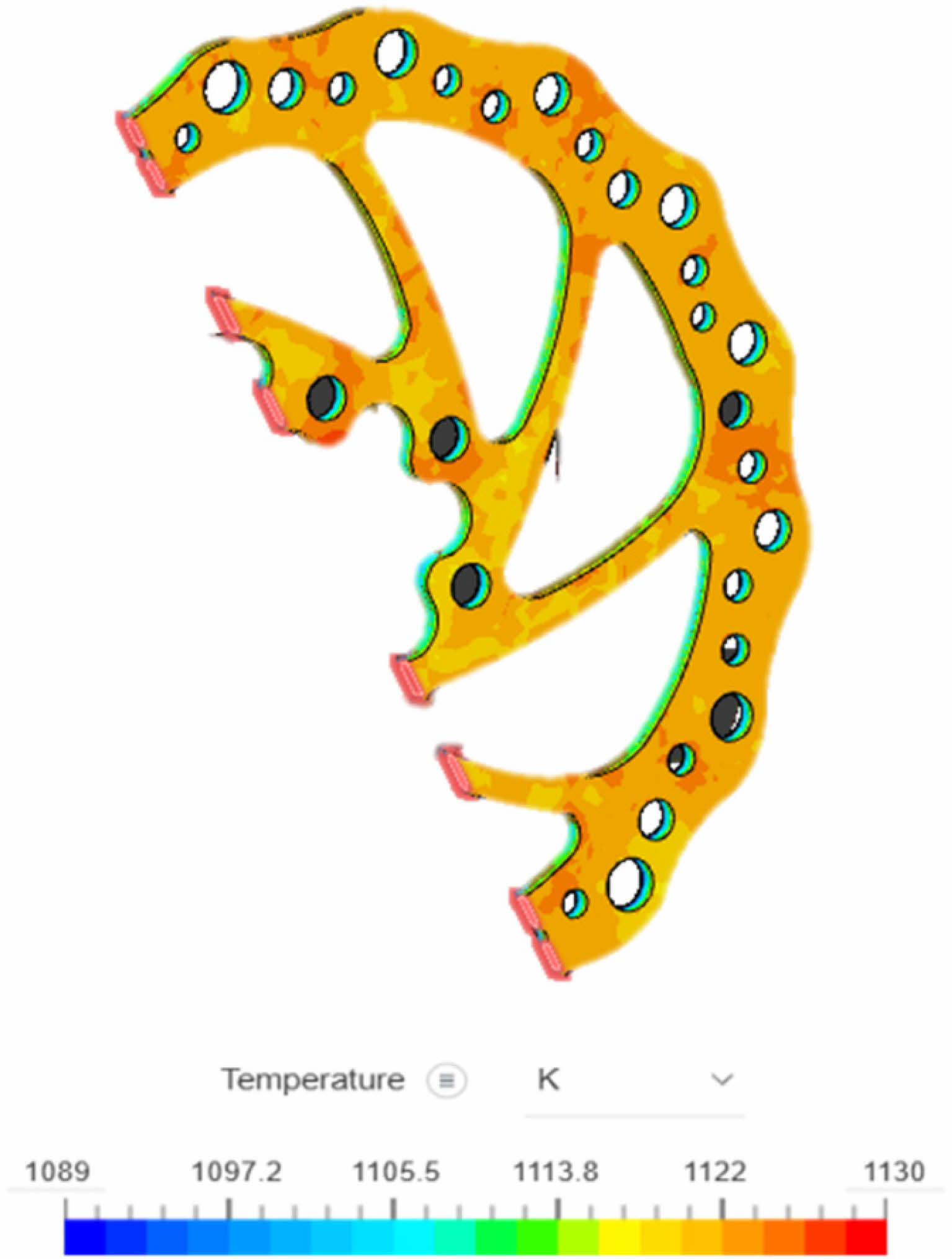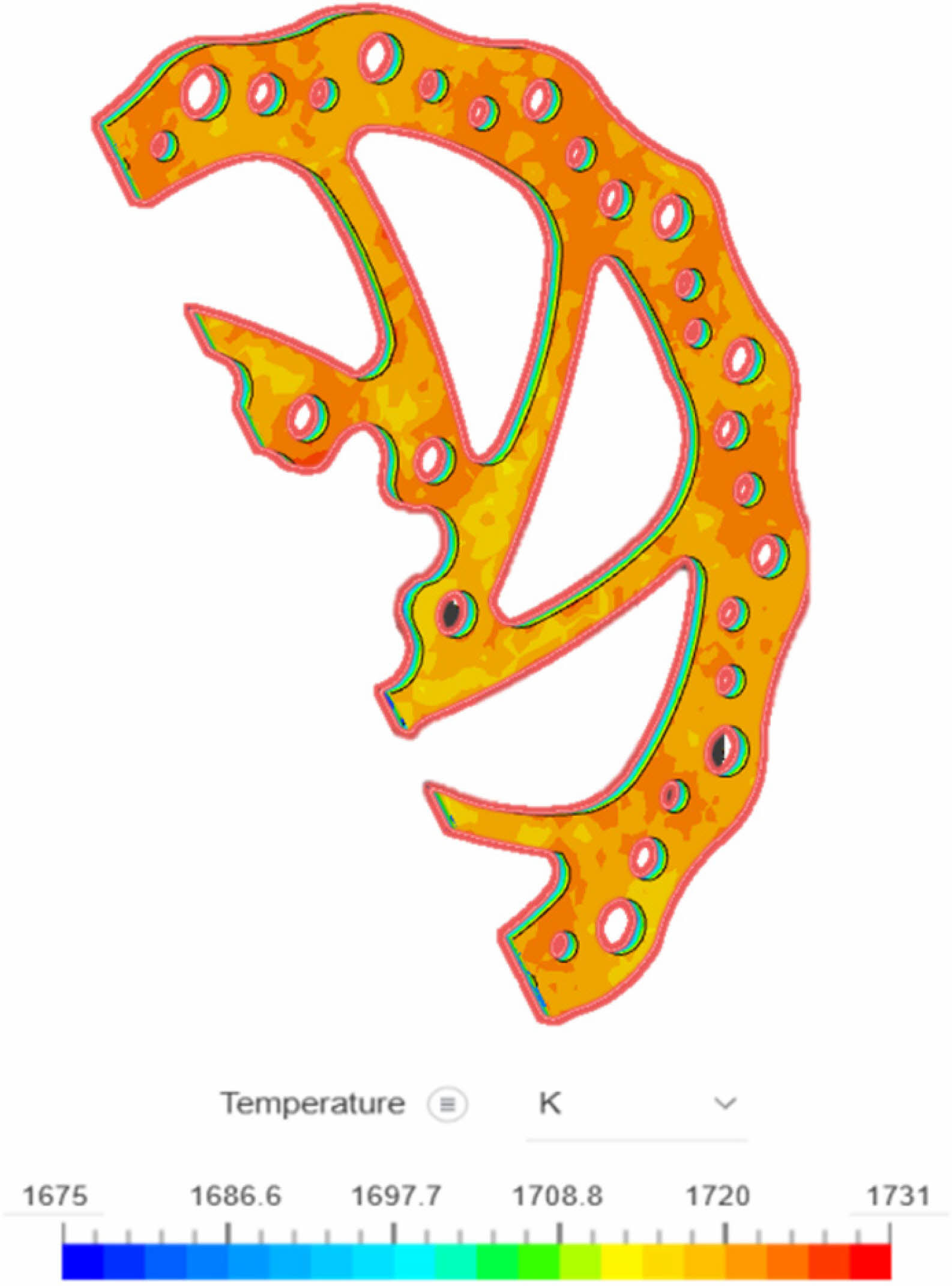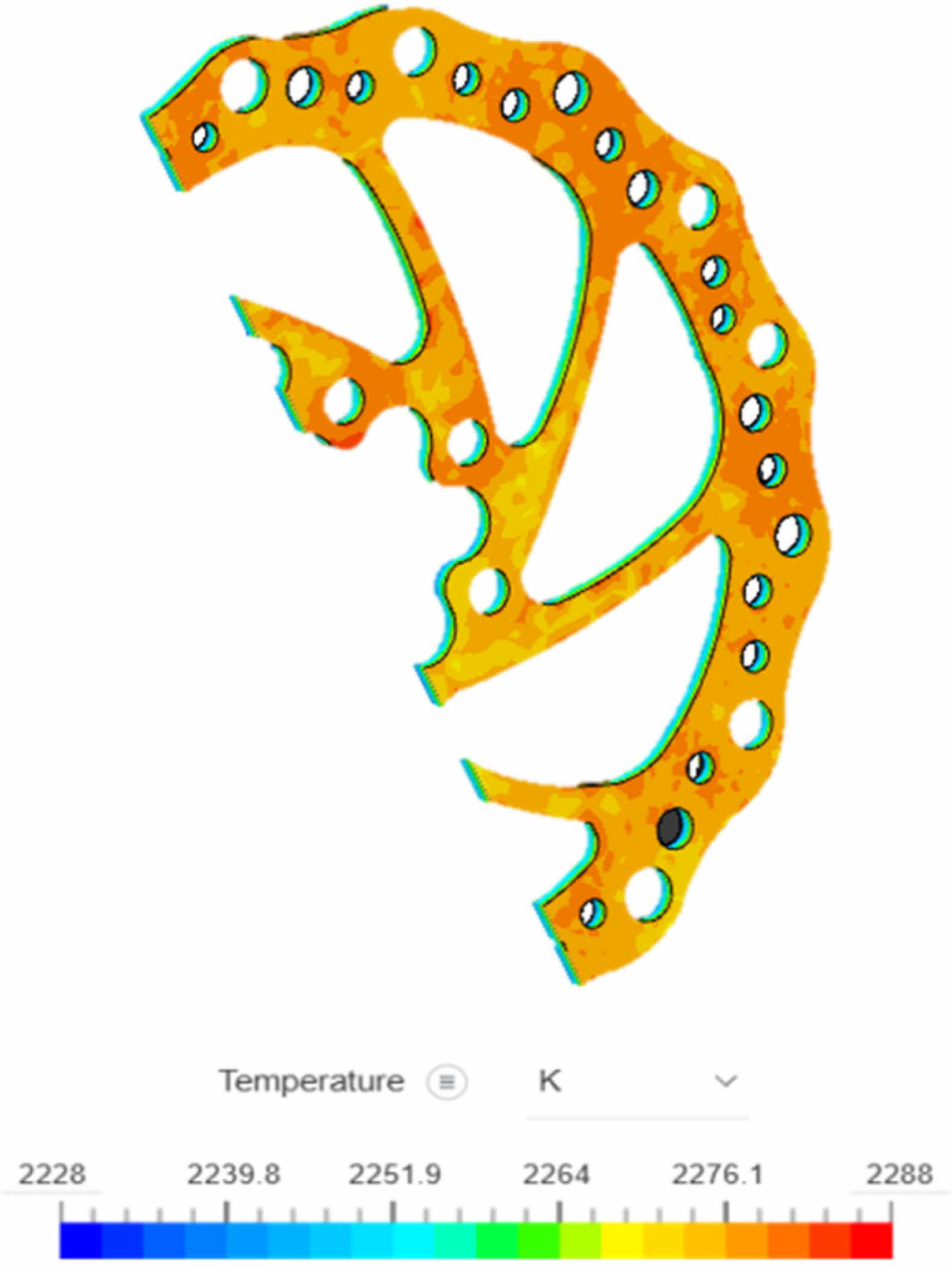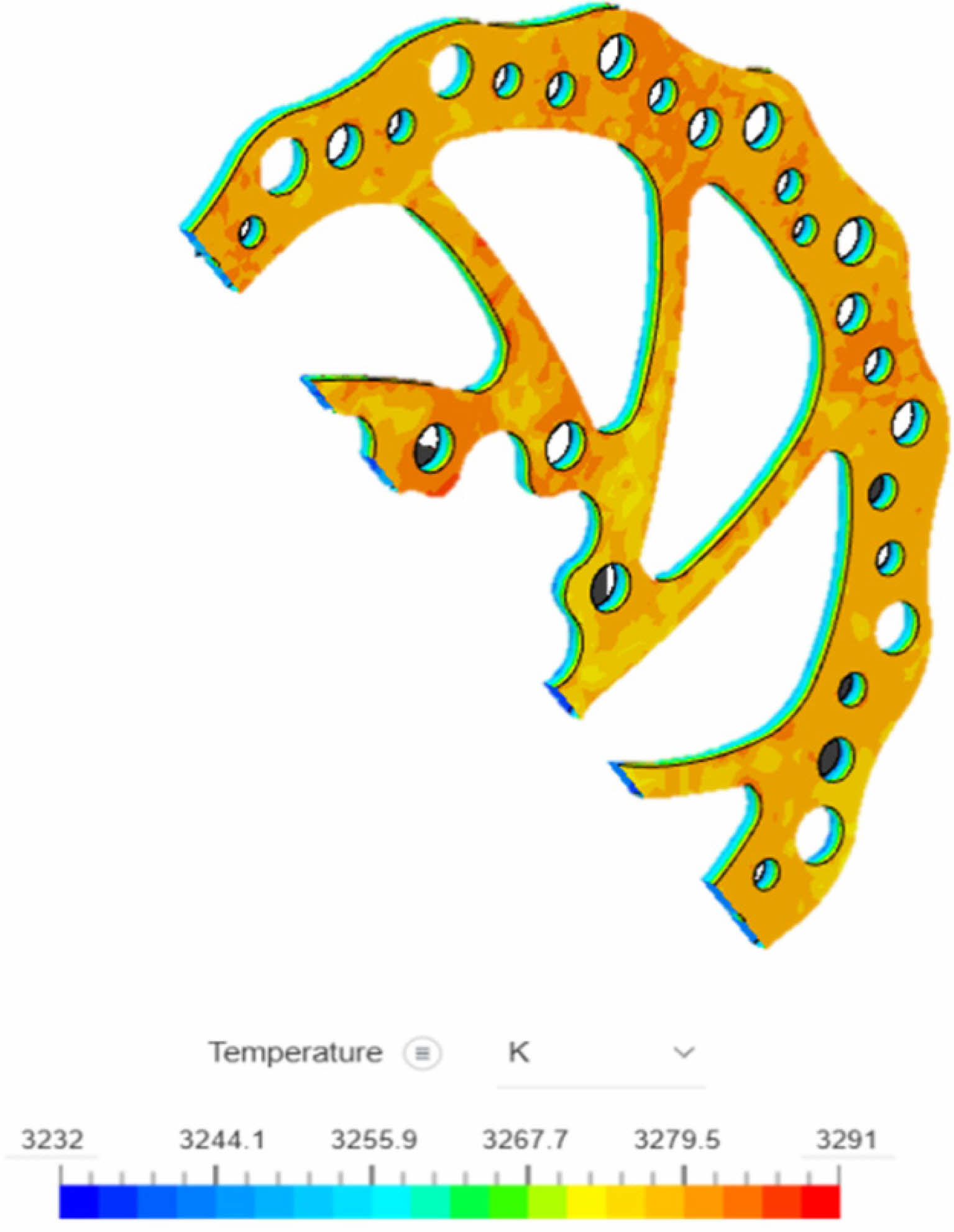- Transient heat transfer analysis of titanium diboride brake discs for high-performance motorsports applications
Yan Hea,* and Yanling Heb
aXinyang Normal University, Xinyang, China
bArchitectural Engineering Institute, Shengda Trade Economics & Management College of Zhengzhou, Zhengzhou, ChinaThis article is an open access article distributed under the terms of the Creative Commons Attribution Non-Commercial License (http://creativecommons.org/licenses/by-nc/4.0) which permits unrestricted non-commercial use, distribution, and reproduction in any medium, provided the original work is properly cited.
This study presents a numerical transient heat transfer analysis of Titanium Diboride (TiB2) brake discs, focusing on their thermal behavior under extreme conditions typical of high-performance motorsports applications. Using Finite Element Analysis (FEA), the temperature distribution across the brake disc was simulated at various time steps, from initial heating to steady-state conditions. The results showed significant thermal gradients, with temperatures rising sharply as the disc absorbed heat due to high surface flux. At the 100s time step, the disc exhibited a considerable temperature increase, with the maximum temperature reaching up to 3286 K in certain regions. The integral heat absorption values indicated uneven thermal load distribution, with certain regions experiencing more heat accumulation. This analysis provided critical insights into thermal stress distribution of TiB2, essential for understanding its wear resistance, thermal shock resistance, and suitability for brake disc applications. These findings contribute to optimizing the design of TiB2 brake discs for enhanced performance and durability in motorsports, particularly in environments where high temperatures and mechanical stresses are prevalent.
Keywords: Titanium Diboride, Sports.
In the high-performance world of motorsports, the demands on materials are extreme, requiring components to endure significant mechanical and thermal stresses [1]. One such critical component is the brake disc, where efficiency, durability, and heat resistance are paramount for ensuring safety and performance. Traditional brake disc materials, such as cast iron, have been commonly used in motorsports; however, they have limitations in withstanding the extreme conditions generated by high-speed racing and frequent thermal cycling [2]. As a result, there is a growing interest in advanced materials like TiB2, which offers exceptional properties, including high hardness, high melting point, outstanding wear resistance, and excellent thermal shock resistance.
TiB2 a ceramic material, has demonstrated promise for use in high-temperature applications due to its superior thermal conductivity and mechanical strength [3-6]. These properties make TiB2 an ideal candidate for the development of brake discs in motorsports, particularly in Formula 1, where brake performance is critical. However, to fully understand the potential of TiB2 in such applications, it is necessary to investigate its thermal behavior under extreme operating conditions, including its response to high thermal loads, transient heat distribution, and thermal stress development [7-10]. This research aims to conduct a numerical transient heat transfer analysis of TiB2 brake discs using FEA to predict thermal stress distribution, temperature gradients, and overall thermal performance over time. By simulating the temperature behavior at various time steps, this study will provide valuable insights into how TiB2 performs under dynamic heating conditions, contributing to the design and optimization of high-performance brake systems in motorsports.
Numerical Analysis
A transient heat transfer analysis was conducted to evaluate the thermal behavior of TiB2 brake discs under high-temperature conditions (Fig. 1). The numerical simulations were performed using SimScale, applying specific thermal boundary conditions to replicate real-world operational scenarios. The global temperature of the system was set at 250°C to simulate high-performance motorsport environments. A surface heat flux of 500,000 W/m² was applied to model the extreme thermal loads experienced during braking events. To account for heat dissipation, convective heat flux conditions were implemented on the outer surface of the brake disc. A heat transfer coefficient of 50 W/m²·K was assigned, with the surrounding ambient temperature maintained at 35°C, representing the cooling effect of airflow during high-speed motion. The thermal properties of TiB2 were incorporated into the simulation, with a density of approximately 4.52 g/cm³ (4520 kg/m³), thermal conductivity ranging between 60-120 W/m·K, and a specific heat capacity of around 500 J/kg·K. These properties were crucial in predicting the temperature distribution, thermal gradients, and possible failure points in the material due to thermal stress [11].
The transient nature of the analysis enabled the assessment of temperature evolution over time, providing insights into heat dissipation rates and material response under continuous thermal cycling

|
Fig. 1 TiB2 Disc brake model and mesh. |
The transient heat transfer analysis (Fig. 2 and Table 1) at a time step of 20 seconds revealed significant temperature variations across different regions of the TiB2 brake disc. The minimum recorded temperature was 1091 K (Region 3), while the maximum temperature reached 1126 K (Region 8). The average temperature across all regions ranged between 1105 K and 1107 K, indicating a relatively uniform heat distribution despite localized variations. The highest integral value of 0.0958 K·m² was observed in Region 3, which also exhibited the largest surface area (8.67 × 10-5 m²), suggesting a correlation between surface exposure and heat accumulation. Region 8, which recorded the highest maximum temperature (1126 K), had an integral value of 0.0925 K·m², highlighting the effects of localized heat concentration. These results indicate that while the overall heat distribution remains stable, certain regions experience slightly higher thermal accumulation, potentially influencing thermal stress and material performance. Further analysis at subsequent time steps will provide insight into the thermal evolution and its impact on the brake disc under transient conditions.
At the 40s time step, the transient heat transfer analysis of the TiB2 brake disc revealed a significant increase in temperature across all analyzed regions (Fig. 3 and Table 2). The minimum recorded temperature was 1678 K (Region 4), while the maximum temperature reached 1726 K (Region 8). The average temperature across the regions ranged from 1697 K to 1700 K, indicating a uniform heat distribution with slight variations due to localized heat accumulation. Compared to the 20s results, there was a noticeable increase in thermal energy across the disc, with the average temperature rising by approximately 590 K. The highest heat accumulation occurred in Region 8, where the maximum temperature was observed. The integral temperature values ranged from 0.1108 K·m² (Region 1) to 0.147 K·m² (Region 3), showing an increase in thermal energy absorption across the surface. Regions with larger surface areas, such as Region 3 and Region 5, exhibited higher integral values, suggesting a greater heat capacity and distribution in those zones. The temperature rise indicates that TiB2 effectively retains and distributes heat under transient conditions, a critical factor in brake disc performance. This analysis provides insights into the thermal behavior of TiB2 brake discs under continuous heat flux, demonstrating their ability to withstand high temperatures while maintaining structural integrity.
At the 60s time step, the transient heat transfer analysis of the TiB2 brake disc exhibited a further rise in temperature across all analyzed regions, indicating continuous heat accumulation (Fig. 4 and Table 3). The minimum temperature recorded was 2231 K (Region 4), while the maximum temperature reached 2283 K (Region 8). The average temperature across the regions ranged between 2251 K and 2254 K, demonstrating a relatively uniform heat distribution with localized temperature variations due to heat flux concentration. Compared to the previous 40s time step, there was an approximate 554 K increase in temperature across all regions, confirming the progressive heat buildup within the material. The highest temperature was observed in Region 8 (2283 K), reinforcing the trend of increased heat retention in this area. The integral temperature values ranged from 0.143 K·m² (Region 1) to 0.195 K·m² (Region 3), with Regions 3 and 5 displaying the highest integral values, suggesting greater heat capacity and energy absorption in those zones due to their larger surface areas. This continued rise in temperature further highlights the high thermal conductivity of TiB2, allowing heat to be distributed efficiently across the brake disc. However, the presence of thermal gradients may contribute to localized stress buildup, which requires further analysis in terms of thermal stress distribution and potential deformation.
At the 80s time step, the transient heat transfer analysis of the TiB2 brake disc revealed a further temperature increase, continuing the trend observed in previous time steps (Fig. 5 and Table 4). The minimum recorded temperature was 2749 K (Region 4), while the maximum reached 2801 K (Region 8). The average temperature values across the regions ranged between 2769 K and 2773 K, indicating a relatively uniform temperature distribution with minor fluctuations due to localized heat accumulation. Compared to the 60s time step, there was an approximate 519 K rise in temperature across all regions, signifying continued heat absorption and limited dissipation due to the imposed boundary conditions. Region 8 displayed the highest maximum temperature (2801 K), reinforcing the trend of localized heat accumulation, which could be attributed to variations in thermal conductivity and convective heat transfer efficiency at different disc sections. The integral temperature values varied from 0.176 K·m² (Region 1) to 0.240 K·m² (Region 3), with Regions 3 and 5 once again exhibiting the highest integral values, suggesting higher thermal storage capacity in these zones due to their larger surface areas. The continuous rise in temperature at this stage indicates that TiB2 effectively conducts and redistributes heat, preventing extreme thermal gradients that could lead to localized hot spots. However, as the brake disc approaches peak operating temperatures, thermal expansion and stress buildup become critical concerns, necessitating further evaluation of the material’s structural stability under prolonged high-temperature exposure.
At the 100s time step, the transient heat transfer analysis of the TiB2 brake disc revealed a notable temperature rise compared to earlier time steps. The minimum temperature across all regions was observed to be around 3235 K (Region 4), while the maximum temperature reached up to 3286 K (Region 8). The average temperature for the disc ranged from 3254 K to 3258 K, showing relatively consistent heating throughout the brake disc. The temperature integral values, representing the total heat absorbed in each region, also increased compared to earlier times, with Region 3 exhibiting the highest integral value of 0.282 (K·m²), indicating that this region absorbed the most thermal energy. This could be due to its larger surface area and its location in the disc, which may have been exposed to higher thermal flux. Other regions such as Region 1 and Region 6 displayed moderate integral values of 0.207 and 0.236 (K·m²), respectively, suggesting slightly less heat absorption in these regions. The 100s time step showed a substantial increase in temperature distribution across the disc, with Region 8 reaching the highest maximum temperature, which is indicative of the heat concentration in the external areas of the brake disc under the applied thermal load. The results highlight how TiB2 brake discs experience significant thermal gradients as they undergo dynamic heating, which is essential in understanding their thermal behavior and ensuring material performance under real-world operating conditions. Fig. 6 Table 5

|
Fig. 2 Temperature distribution in the TiB2 brake disc after 20s, showing variations in heat accumulation across different regions. |

|
Fig. 3 Temperature distribution in the TiB2 brake disc after 40s, showing variations in heat accumulation across different regions. |

|
Fig. 4 Temperature distribution in the TiB2 brake disc after 60s, showing variations in heat accumulation across different regions. |

|
Fig. 5 Temperature distribution in the TiB2 brake disc after 80s, showing variations in heat accumulation across different regions. |

|
Fig. 6 Temperature distribution in the TiB2 brake disc after 100s, showing variations in heat accumulation across different regions. |
|
Table 1 Transient temperature distribution across different regions of the TiB2 brake disc at 20s. |

|
Table 2 Transient temperature distribution across different regions of the TiB2 brake disc at 40s. |

|
Table 3 Transient temperature distribution across different regions of the TiB2 brake disc at 60s. |

|
Table 4 Transient temperature distribution across different regions of the TiB2 brake disc at 80s. |

|
Table 5 Transient temperature distribution across different regions of the TiB2 brake disc at 100s. |

The numerical transient heat transfer analysis of Titanium Diboride (TiB2) brake discs revealed a detailed understanding of the material’s thermal performance under extreme conditions, such as those encountered in high-performance motorsports. The results indicated that the temperature distribution across the disc varied significantly with time, demonstrating the material’s ability to withstand high thermal loads. At the 100s time step, the temperature increased substantially, with regions closer to the surface experiencing higher thermal stresses. This thermal gradient is critical in assessing TiB2’s suitability for brake disc applications, as it plays a pivotal role in the disc’s wear resistance, thermal shock resistance, and overall performance in real-world scenarios. The analysis provided insights into heat absorption and dissipation in different regions, which is crucial for optimizing brake disc design and ensuring durability under repetitive thermal and mechanical stresses. TiB2 demonstrated promising characteristics for high-temperature applications, showing effective thermal management that can improve the performance and safety of brake systems in motorsports.
- 1. J. Qu, P.J. Blau, and N.S. Kulkarni, Wear 258 (2005) 1348-1356.
-

- 2. P.J. Blau and J.C. McLaughlin, Tribol. Int. 36[10] (2003) 709-715.
-

- 3. M.A. Ahdy, M.K.A. Ali, M. Mourad, and A.M. Abd-El-Tawwab, P I Mech. Eng. J-J Eng. 236 (2022) 1445-1465.
-

- 4. N.M. Kinkaid, O.M. O'Reilly, and P. Papadopoulos, J. Sound Vib. 267 (2003) 105-166.
-

- 5. A.A. Agbeleye, D.E. Esezobor, S.A. Balogun, J.O. Agunsoye, J. Solis, and A. Neville, King Saud Univ. Sci. 32 (2020) 21-28.
-

- 6. F. Ahmad, S.J. Lo, M. Aslam, and A. Haziq, Procedia Engineer, 68 (2013) 674-680.
-

- 7. P. Samal, B. Surekha, and P.R. Vundavilli, Silicon. 14 (2022) 3317-3328.
-

- 8. N. Sangeetha, V.M. Brathikan, R.K. Nitheeshwar, and S. Jayabalu, J. Ceram. Process. Res. 23[4] (2022) 529-534.
-

- 9. D. Rajagopal, A. Kumaravel, S. Arunprasath, M. Dinesh Babu, and S. Elayaraja, J. Ceram. Process. Res. 25[1] (2024) 119-130.
-

- 10. C.A.V. Kumar and J.S. Rajadurai, Trans. Nonferrous Met. Soc. China 26 (2016) 63-73.
-

- 11. S.R. Patil, K.P. Powar, and S.M. Sawant, Appl. Therm. Eng. 98 (2016) 238-245.
-

 This Article
This Article
-
2025; 26(2): 307-312
Published on Apr 30, 2025
- 10.36410/jcpr.2025.26.2.307
- Received on Mar 22, 2025
- Revised on Apr 4, 2025
- Accepted on Apr 8, 2025
 Services
Services
Shared
 Correspondence to
Correspondence to
- Yan He
-
Xinyang Normal University, Xinyang, China
Tel : 18203766828 Fax: 03766391866 - E-mail: xysdhy0816@163.com






 Copyright 2019 International Orgranization for Ceramic Processing. All rights reserved.
Copyright 2019 International Orgranization for Ceramic Processing. All rights reserved.